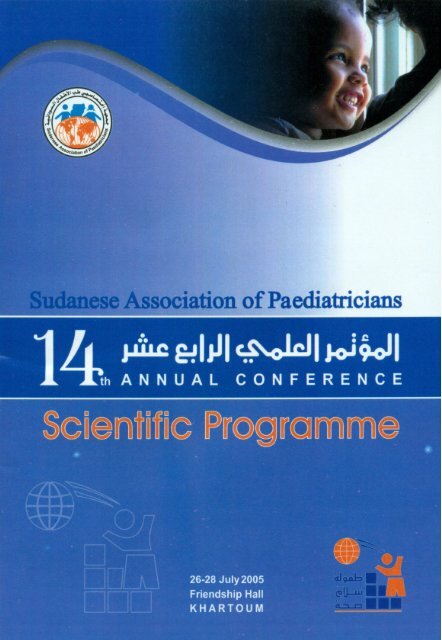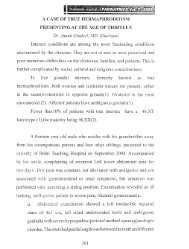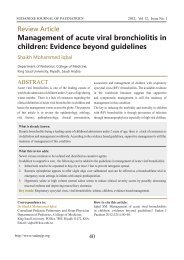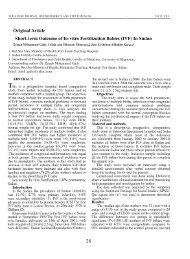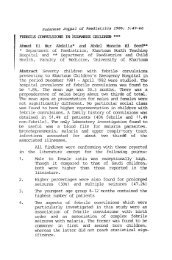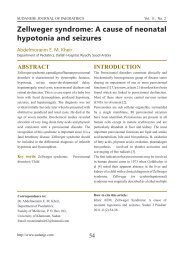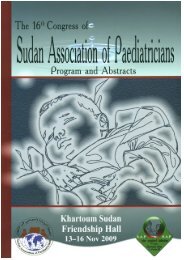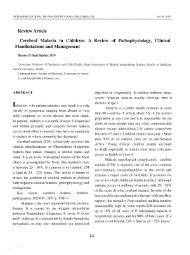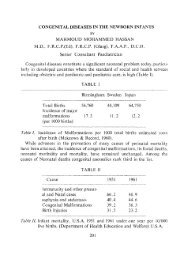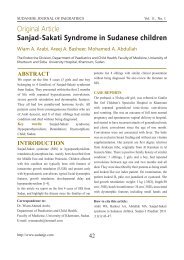conference programme and abstracts book - Sudanjp.org
conference programme and abstracts book - Sudanjp.org
conference programme and abstracts book - Sudanjp.org
Create successful ePaper yourself
Turn your PDF publications into a flip-book with our unique Google optimized e-Paper software.
NEW AUGMENTIN SYRUP TWICE DAILYWELL TOLERA TEDAugmentinSyrup twice daily ISwell toleratedAugmcntin Syrup twice dally IS available III a $Ugar·frcefi'\jlt ftaoIoured suspensIon'Simple t\VIce-daJ1y dosIng'DOSINGSCHEDULEEWGMENTISyrupSIMPLE & EFFECTIVE
ScientificCommittee:Pro!'. Zien Alabdeen Karrar (Chairman)Dr. Ibrahim E. Elaaela (Convernor)Prof. hafiz Shazali - MemberProf. Abdulwahab AlidreesyProf. Hassan Mohamed AhmedProf. Mabyo MustafaProf. Salah Ahmed Ibrahim"rof Abdulrahman Elmuftil"lrof. Mutawali HusseinProf. Ahmed Hamed AlabbadiProf. Gaafar Ibn AufProf. Ali HabbourOr. Yahia ShakirDr. Balla Awad EIseedOr. Omaima M. SabirDr. Elfatih AbuzidDr. Kamal M. KnionOr. Hassan Osman Omer (Member)Dr. Yahia Omer Hamza (Member)••110011114 •• D D ~,.; .%r' (. h((ltr JI(-,)r'. fly)('r';rr!ir'll r/ :-/ :rr'r/r'rrfdr/r( 11
Liaison CommitteeProf. Salah Ahmed IbrahimDr. Walideen AlfakiProf. Sayda BasharDr. Atiat MustafaDr. Kamal Mohamed KheirDr. Bakhita AtallaDr. Sirag Mohamed KheirDr. Mohamed Osman MutwakilDr. Ali ArabiDr. Ahmed ElfadilDr. Muntasir TahaDr. Suad Eltigani AlmahiDr. Haydar ElhadiProf. Amna Mohamed SalihDr.Babiker AlmubasharDr. Khalid YousifDr. Nuha A/GhafarDr. Sara A/SalamDr. Amani GendilDr. Ibrahim A/GaderD11 D
Printing Materials CommitteeProf. Zein A. KarrarOr. Ali ArabiOr. Yasir Mahgoub MohammedMs. Huda Khalid AhmedMr. Mustafa Agabani, Design & SettingDD
TuesdayJuly 26 th.200SRegional HalKhartoumNeurologyHall08:00 - 09:0009:00 - 10:3010:30 - II :00II :00 - 12:05Africa HallRegistrationOpening sessionBreakfastFirst plenary sessionChairman: Dr. Ahmed Hassab El RasoulCo chairman Dr. Yahia Omer Hamza: Prof. Sayda Bashar11:00 - 11:30 Peripheral neuropathyProf. M. A. M. Salih11:30 - 12:00HydrocephalusOr. Waleed Murshed12:00 - 12:3012:30 - 12:45DiscussionBreak12:45 - 02:05 Ist free communicationsessionChairmanCo chairmanProf. Mustafa Abdella: Dr. Elkhair Khogal12:45 - 0 I :00 Acute Flaccid Paralysis, inPort SudanDr. Khalid Elkhair01 :00 - 0 I: IS Patterns of childhood Epilepsyin theEastern Province of Saudi ArabiaDr. EI-Sayed Ali01: 15 - 0 I :30 The Importance of EEGPaediatricansOr. Taha Sadig Taha01 :30 - 01 :45 Neural Tube DefectsDr. Ghada Eltahir01 :45 - 02:05 Discussion12:45 - 02:05 3rd free communicationsessionAfrica HallHaematology& OncologyOmdurman HallNeurition & DMChairmanCo chairman: Dr. Elsir HashimDr. A/Muniem BanagaChairmanCo chairmanProf. Mustafa Abdella: Dr. Elkhair Khogal12:45 - 0 I :00 Pattern of childhood cancer,in SudanDr. Huda Haroun01 :00 - 0 I: 15 Dyskeratosis congenitacase reportDr. A/Rahim Satti01: 15 - 0 I :30 Audit of management ofsickle cell crises inChildren in a London HospitalDr. A/Moniem M. Hamid01:30 - 01:45 Correlation betweenPlasma Level ofV.W.F <strong>and</strong> severity of Sickle CellDisease01 :45 - 02 :05 Discussion12:45 - 02:05 2nd free communicationsession12:45 - 01:00 Hospital treatment ofProtienEmergencyMlanutrition Using Gerira FormulaProf. Hassan M. Ahmed01 :00 - 0 I: 15 Weight Gain <strong>and</strong> Survivalof (SAM) Treatedwith IM Ceftriaxone Vs. AmoxicillinProf. Salah A. Ibrahim01: 15 - 01:30 Diabetes Mellitus, ketonbodies in DKADr. Samar Abu Samra01:30 - 01:45 The Role of the PaediatricDiabetesSpecialist NurseDr. Assad T. Elabbas01:45 - 02:05 Discussion
WednesdayJuly 27th.200S08:30 - 11:00AfricaHallChairman:Prof Gaffar Ibn OufCo chairman:Dr. Prof. MutwaliAlMaged,Dr. Suad Eltigani08:30 - 09:00 Advanced Paediatric LiveSupport (APLS), Dr. Raif Higazi09:00 - 09:30 The Ethics of pr act icingPaediatricProf. A.T.H.Eldrissy09:30 - 10:00 Clinical Govemce ModelDr. Hadi Almalik10:00 - 10:30 Neoroirnaging of Cerebral10:30 - 11:0011:00 - 11:30Second Plenary SessionMalformationProf. Mamdoh MahfouzDiscussionBreakfast11:30 - 01:50 4th Free CommunicationSessionAfrica HallNeonatologyChairmanCo chairman01:05 - 01:2001 :20 - 01 :3501 :35 - 01 :5001 :50 - 02:0502:05 - 02:2511:30 - 02:25KhartoumcardiologyChairmanCo chairmanHallAlRahim Mohamed ZeinDr. Mohamed OsmanMutwakil,Dr. Khalid ElkhairNeonatal IMCIProf. Salah IbrahimPhototherapy blue V whiteLightOr. Abu Obaida BalaNeonatal Gall BladderStone, Case ReportDr. Ibrahirn G. EldawlaInfant FeedingDr. Maha GadallahDiscussion5th free communicationsession: Dr. ElmuftiDr. Yahia Shaker, Or. AliArabiAfrica HallNeonatologyChairmanCo chairman11:30 - 11:4511:45 - 12:0012:00-12:1512:15 - 12:3012:30-12:5012:50 - 01 :05: Prof Essa ElaminOr. Fawzy A/Rahim, Dr.Huda HarounCPAPDr.Mohamed ZienManagement of Babies ofHepatitis C MothersOr. AbushukMorbidity <strong>and</strong> Mortality inMygomaDr. Yara BadereldinIVF babiesOr. Zeinab Mohamed GailyOiscursionBreak11:30 - 11:4511:45 - 12:0012:00-12:1512:15-12:3012:30-12:4512:45 - 01:0501 :05 - 01:20Pattern of Cardiac Diseasein Sudan Heart CenterOr. Sulafa KM. AIiGuide lines of EchocardiologyDr. Elfatih AboziedEchocardiographic findingsin Sudanese childrenat Ahmed Gasim HospitalOr. Siham A. H. El-RasoulBalloon Valvuloplasty forCritical Neonatal AorticStenosis: Initial Results& Long-term Follow upDr. Osama Hafiz ElshazalyPattern of valvular involvement in RHODr. Samia HassanDisscusionBreak
KhartoumCommunityHallPaediatricOmdurman HallTropici & Infection DiseaseChairmanCo chairman01:20 - 01 :3501 :35 - 01:5001 :50 - 02:0502:05 - 02:2511:30 - 02:25Prof. Hassan MohamedAhmedDr. Kamal MohamedKhair, Dr. Hydar ElhadiStreet Children, Health <strong>and</strong>Social AspectsOr. Abdel Latif IbrahimReformatories ChildrenMedical <strong>and</strong> Social AspectsDr. Sanaa K. MukhtarPrevalence Intestinal Parasitesin Jabal Awlia AreaOr. Amira EltaibDiscussion6th free communicationsessionChairmanCo chairman: Dr. Atiat MustafaDr. Surag Mohamed01 :20 - 0 I :35 Pattern of Sever Malaria inSudaneseDr. Zeidan A. Zeidan01 :35 - 01:50 Neonatal Out come ofsever Malaria with pregnancyOr. AtifB. Fazary01: 50 - 02 :05 Mothers Perception,Knowledge <strong>and</strong>Practices regarding Childhood MalariaOr. Mubark A. Mohamed.02:05 - 02:30 DiscussionThursdayJuly 28th .2005Omdurman HallTropici & Infection DiseaseAfrica Hall08:30 -10:30 Third plenary sessionChairmanCo chairman: Prof. Ali HabourDr. Mahgoub M. Adarn,Or. Hytham ElsaidChairmanCo chairman: Prof. Hafiz Elshazali: Dr. Elhadi Elmalik,Dr. Bakheta Ataalla11:30 - 11:4511:45 - 12:0012:00 - 12: 1512:15 - 12:3012:30 - 12:4512:45 - 01:0501 :05 - 01 :20Paediatric TB Diagnosis &Treatment (U.K)Dr. Hytham BashirTB Diagnosis <strong>and</strong> treatment(Sudan)Dr. MuawiaDengue FeverOr. Amal MalikVertical Transmission ofHepatitis B VirusDr. Hatim GendilInfection Caused by HiBOr. Karim Eldin M. AliDiscussionBreak08:30 - 09:00 HIV + Breast. FeedingDr. Taha Eltahir Taha09:00 - 09:30 Expectrum of improvementof child health in southern Sudan09:30 - 10:0010:00 - 10:3010:30 - 11:00Dr. TongChild Health policy insouthern SudanFedreal Ministry of HealthDr. Eltaib A. SaidDiscussionBreakfast11:00 -12:35 7th free communicationsession
Africa HallCardiac & Renal SessionChairmanCo chairman: Prof EledressyDr. Younis , Dr. Elfatih11:00 - 11: 15 Clinical indicators ofserving of Sickle Cell AnaemiaDr. Nagwa Elhassan11:15 - 11:30 Cardiac Lesion in SickleCell AnaemiaDr. Ghada Osman1I :30 - 11:45 Cardiac Disease in ChronicRenal FailureOr. Tamadur Elnur11:45 - 12:00 Outcome of Treatment ofNephrotic SyndromeDr. Mriam Beliel12:00-12:1512:15 - 12:35Or. Mohamed ElaminDiscussion11:00 - 12:30 8th free communicationseSSIOnOmdurman HallMiscellaneous SessionChairmanCo chairmanProf Salah Ibrahim: Dr. Nour ElaminOsman, Dr. Bala Elsharief11:00 - 11: 15 Evaluation of MedicalSchools in Sudan,Juba UniversityDr. Walyeldin El-Nour El-Fakey11:15 - I \:30 Enuresis ClinicOr. AJ Azim Mohd Mabrouk11:30 - 11:45 Experience of YoungDoctors in UKDr. R<strong>and</strong>a Eltegani11:45 - 12:00 Nurse Role in ReducingMorbidity <strong>and</strong> MortalitySister Batoul12:00 - 12:15Or.12:15 - 12:35 Discussion_KHartoum HallSouth SessionChairmanCo chairmanProf. Z. A. Karrar: Dr. Rose AjakII:00 - 11:I0 Child Health indicatorsProf. Z. A. Karrar11:10 - 1I :25 Child Health in the South,Previous Experience <strong>and</strong> Future ProspectsProf. Mabyou M. AJ Wahb11:25 - 11:40 Child Human Security inPost-Conflict SudanDr. Hassan El Obied11:40 - 11:55 Post War PsychologicalTrauma to ChildrenOr. AJ Basit Merghani11:55-12:10Dr._12:10 - 12:30 Discussion11:00 - 12:35 9th free communicationseSSIOn
Peripheral Neuropathiesin ChildrenProf. M. A. M. SalihThe paper provides an update on acute <strong>and</strong> chronic forms of peripheral neuropathiesin children. Acute forms result in acute flaccial paralysis <strong>and</strong> include neuropathiesof infectious diseases such as diphtheria, brucellosis <strong>and</strong> neuroborreliosis. They alsoinclude acute toxic neuropathies due to heavy metals (lead <strong>and</strong> mercury) <strong>and</strong> <strong>org</strong>anophosphates.Following success in controlling immunizable diseases in childhood, theimmune-mediated neuropathy, Guillain-Barre syndrome, is gaining significant importance.The review will highlight the subtypes of Guillaine Barre syndrome (includingMiller Fisher syndrome), their pathogenesis <strong>and</strong> recommended protocols for theirmanagement.Chronic forms, on the other h<strong>and</strong>, encompass the inherited diseases of the peripheralnerves. Of these, the autosomal recessive (AR) types of Charcot-Marie-Tooth (CMT)are relatively more prevalent in North Africa <strong>and</strong> the Arabian Peninsula because ofthe high rate of consanguinity. This contrasts with the mainly dominant forms seenin Europe <strong>and</strong> the US. Two major phenotypes have been distinguished, in which theneuropathy is either demyelinating (CMTl) or axonal (CMT2). Several new entitieswere described in highly inbred Saudi Arabian <strong>and</strong> North African countries. Currently,more than 9 loci <strong>and</strong> 6 genes have been identified.In a collaborative research, we described the first identified gene causing an AR type ofCMT. The gene (Myotubularin-related 2 gene, MTMR2) <strong>and</strong> its mutations that lead toan AR severe demyelinating neuropathy, was identified in one Italian kindred <strong>and</strong> twoSaudi Arabian families. This gene, located on chromosome 11q22, was found to encodethe myotubularin related protein2. Further studies on the Saudi <strong>and</strong> Italian familiesrevealed that MTMR2 interacts with neurofilament light chain protein (NF-L), thedeficiency of which causes another axonal form of CMT (CMT2E). The data furthersupported the notion that hereditary demyelinating <strong>and</strong> axonal neuropathies may representdifferential clinical manifestations of a common pathological mechanism.Other phenotypically novel myelinopathies, axonopathies <strong>and</strong> other complex forms ofCMT that have been described in North African <strong>and</strong> Saudi Arabian populations awaitto have their genetic loci unravelled. In another joint study, we described a new genethat causes spinocerebellar ataxia associated with axonal neuropathy (SCAN 1). Thegene, Tyrosyl-DNA phosphodiesterase 1 (TDP 1) may cause SCAN I either by interferingwith DNA transcription or by inducing apoptosis in postmitolic neurons.
Child Human SecurityIn post conflict SudanBy: Dr. Hussein Elobeid.helobeid@hotmaiI.comNation coming of along st<strong>and</strong>ing intrastate conflict experience a shift in perspectivefrom state to individual human security <strong>and</strong> Sudan is a classical example. The GoS<strong>and</strong> SPLM/A have identified, through the JAM process, the human security elementsof l<strong>and</strong>mines action, DDR, IDPs reintegration <strong>and</strong> SSR as the corner-stone for peacebuilding, However, l<strong>and</strong>mines, firearms <strong>and</strong> unaccopmaniedness are considered as themajor child human security threats. Almost all the battlefields of the civil war (TheSouth,NM,BN <strong>and</strong> Kassala) have witnessed indiscriminate use of l<strong>and</strong>mines. L<strong>and</strong>mineswill continue to maim <strong>and</strong> kill (20 - 50% mortality rate) humans, particularlycivilian population (92% of the victims in Kassala state were civilians). L<strong>and</strong>linesdenied access to health facilities in Kassala state (9% of hospitals, 5% of health centres<strong>and</strong> 3% of the dispensaries). The food security was severely affected in Kassala state<strong>and</strong> consequently impacted the health <strong>and</strong> nutrition, particularly that of women <strong>and</strong>children. Availability <strong>and</strong> use of SALW create insecurity, encourage crime, freeze communitydevelopment <strong>and</strong> deny the future generation (children) their right for survival<strong>and</strong> development. The redundancy of 100,000 child solders <strong>and</strong> availability of SALWconstitute a major security hazard <strong>and</strong> exacerbate childhood vulnerability. Physical<strong>and</strong> psychological trauma, spread of infectious diseases including HIV IAIDS <strong>and</strong> childdestitute in general impose extra health burdens. Unaccompanied minors released fromthe war hostage back to the communities a pause daunting challenger for action.Child health professionals are at cross-roads to decide on how to react to child healthchallenges for post conflict Sudan, at the broader political l<strong>and</strong>scape, whereby contributingto durable peace building of the nation.An Update on Childhood NeuromuscularDisordersMustafa A.M. SalihProfessor; Division of Paediatric Neurology. Department of Paediatrics. College of Medicine,King Saud University, Riyadh, Saudi ArabiaThe paper highlights the epidemiologic, clinical <strong>and</strong> genetic profile of neuromusculardisorders in childhood <strong>and</strong> the contribution of research from the Region to the identificationof new entities <strong>and</strong> unravelling of the molecular pathologic features of these
diseases. This is expected to help in prevention through informed genetic counselling<strong>and</strong> in designing new modalities of therapy.With regards to diseases of muscle, it has been established that the integrity of thecytoskeletal-extracellular linkage, mediated by the dystrophin glycoprotein complex(DGC), is important to the muscle membrane stability, <strong>and</strong> loss or abnormality of certaincomponents lead to a disruption of this linkage <strong>and</strong> cause various forms of MD. Sofar, at least seven different MDs are related to abnormalities of the DGC."Adhalin", derived from the Arabic word "Adhal" for muscle, is one of the DGC whichhas recently been implicated in the pathogenesis of severe childhood autosomal recessivemuscular dystrophy (SCARMD). During the last two decades, (SCARMD) wasidentified as a unique form of MD with high prevalence in populations of Arab descentin Africa <strong>and</strong> the Middle East. Over the decade 1982-1993, it was found to be commoner(30%) than Duchenne MD (25°/.)) <strong>and</strong> similar to congenital MD (30%) at KingKhalid University Hospital (KKUH) in Riyadh.The paper reviews the clinical <strong>and</strong> molecular pathological features of SCARMD seenin Sudan <strong>and</strong> Saudi Arabia; a newly described form of MD associated with deficiencyof a component of the DGC ( -dystroglycan); <strong>and</strong> a novel mutation in a Saudi familywith congenital MD due to partial deficiency of another component of the DGC (i.e.merosin or LAMA2). A fifth new variant or congenital MD characterized by arthrogryposismultiplex, cobblestone lissencephaly <strong>and</strong> merosin (LAMA2)-positive immunohistochemistrywill also be described, as well as, a sixth novel form (Salih, CMD).The latter was first described in a Sudanese family <strong>and</strong> is characterized by congenitalhypotonia associated with minimal myopathic changes <strong>and</strong> type-I fibre predominanceon muscle histology. Following achievement of motor developmental milestones, affectedpatients started to show progressive weakness associated with features of leftventricular dilated cardiomyopathy. Repeated muscle biopsies revealed florid dystrophicfeatures with normal expression of the DGC, including merosin (LAMA2).Integrin 7 <strong>and</strong> -dystroglycan (which has been discovered recently to be deficientin sub-groups of patients who present with congenital MD) were normally expressedin thesepatients.
Mothers' Perception, Knowledge <strong>and</strong> Practices regardingChildhood Malaria in SudanMubarak AI Rahman Mohamed, MBBS tu. of K.)Professor Zein Alabdin A. KarrarThis is a descriptive, cross-sectional, community-based study conducted between January-June2004. Five areas representing the endemicity categories in Sudan were selected.They were Khartoum (urban malaria), Sh<strong>and</strong>i (hypo endemic), Gedarif(seasonalmalaria), Kenana (irrigated malaria) <strong>and</strong> Wau (Perennial high transmission malaria).655 mothers of under 5 children were chosen through a multi stage r<strong>and</strong>om sampling;200 of them at health facilities accompanying their febrile children, who were examined& a BFFM was taken for them <strong>and</strong> 455 mothers at household level.330 (50.4%) of mothers, reported fever in last two weeks, 180(55.6%) of these weredue to malaria. However, the reported incidence of malaria during the survey time wasonly 11(5.5%).The perceived causes of fever were malaria in 396(62.8%), pneumonia 286(43.3%)& measles 92(14.6%). Convulsions as a risk of high fever was mentioned by 373(57.9%). Educated mother were significantly had better knowledge about fever causes<strong>and</strong> risk factors than illiterates.The causes of malaria as perceived by mothers include: mosquito 558(86.3%) exhaustion,dirt, bad food & blood transfusion. Fever <strong>and</strong> vomiting were the commonestsymptoms of malaria mentioned by 532(82%) & 380(58.6%) respectively; whilecough was the least 47(7.2%).More than 254 (40%) mothers think that severe malaria presents with convulsions,wnle only 25 (3.9%) mentioned jaundice <strong>and</strong>/or pallor. Education significantly affectskoowledge of danger signs, but ages of the mothers significant only in not able to drinkor breast -feed.595 (93.4%) mothers thought that BFFM was important, but 366 (56.4%) believed thatartipyretics given at home will affect the result.4E5(74.7%) of mothers sought help at a HF for childhood fever, 276(42.5%) gavehone-treatment <strong>and</strong> 52(8%) visited traditional healers. For malaria 608(93.7%) visiteda :-IF,26 (4%) gave home treatment <strong>and</strong> only 28(4.3%) went to traditional healers;hcwever, only 13(6.6%) visited HF within 24 hrs of fever.Fa convulsion, 355(55.8%) would visit HF & only 22(3.2%) mentioned traditionalhealers. Home-treatment of fever included cool bath in 327(57.8%), paracetamol in122(21.6%) <strong>and</strong> home remedies in 62( 11%). Traditional treatment of malaria includeduse of Aradaib (Tamarindus indica), Neem, Bee stings & others. Chloroquine was theco:nmonest antimalarial mentioned by 597(93.7%) <strong>and</strong> artemether was the least repcrtedby 54(8.5%). Correct chloroquine dose was given by 67(72%) & two thirds ofmothers preferred oral drugs.
Bed nets as prevention method was mentioned by 524(80.8%), but only 214(59.3%)were using bed nets.The direct cost of malaria treatment ranged from 0.19 to 76.6 US$ with an average 4.7us $; <strong>and</strong> the media was the main source of information about malaria to 196 (33.4%)of mothers, health worker to 143(24.4%) <strong>and</strong> 225(38.3%) had only their own experience.Education <strong>and</strong> age of the mother affects their knowledge & practices towardsfebrile children especially in treatment seeking, using tepid spongies at home <strong>and</strong> goodknowledge about malaria prevention. Implementing IMCI strategy & reducing the costof treatment for under 5 years children are important in improving health seeking behaviour<strong>and</strong> then malaria control.The Ethics of Practicing PaediatricsA.T.H. ElidrissyThe duty of physician practicing paediatrics is to care for a sick child with the aim ofpreventing mortality <strong>and</strong> reducing morbidity. To achieve this it is vital to prevent tlekilling 6 diseases . The cost of providing curative <strong>and</strong> preventive measures is the e-sponsibility of the government <strong>and</strong> it is a priority tm medical personnel. Islam staredthe support of children's life <strong>and</strong> health. The first person to do this was the secoidKhalifa Syidna Om er IBN Al Khattab who was giving subsidiary to prevent malnutitionto every child after being weaned, but on noticing that mothers were resolving toearly weaning (i.e. before completing 2 years), he ordered subsistence for every chldborn in the Islamic governments from Iraq to Egypt .Accordingly health of childenis the responsibility of the Islamic government .Parents specially in the poor secorof the community can not afford to pay for cost of curative paediatrics. We paediaricians,<strong>and</strong> definitely everybody else, strongly believe that children are born to li-e.Accordingly, any childhood disease is an emergency <strong>and</strong> comes under the PresidentOmer AI-Bashir's ruling for Free Emergency Services to everybody. Any sick chldshould benefit from this presidential statement <strong>and</strong> treated free of charge in any snteor national government curative institute.The physicians working in paediatrics also should follow the code of ethics of practcewhich is in line with all religions. In Islam, Ibn Alqa'im Aljouzia has put the 20 conm<strong>and</strong>sof ethical practice which should be followed by every physician.Our aim is a healthy children community to have a healthy future based on devotim,justice <strong>and</strong> mercy.
An Open R<strong>and</strong>omized Clinical Trial to Compare Weight Gain<strong>and</strong> Survival in Acutely Malnourished Children Treated with aTwo-day Intramuscular Ceftriaxone Regimen Versus St<strong>and</strong>ardOral Amoxicillin1- Vincent Brown2- Christine Dubray3- Salah Ahmed Ibrahim4- Mohammed A/Muttalib1- Director, Epicentre - MSF, Paris2- Clinical trial researcher, MSF, Khartoum3 Department of Child Health, Faculty of Medicine, U of KSevere acute malnutrition (SAM) has long time been recognized as a major publichealth issue. The association between infection <strong>and</strong> SAM has been largely documented.To lower deaths associated with infection, systematic broad-spectrum antibiotichas been recommended for the management of SAM However the appropriate antibioticregimen which is effective, of low cost <strong>and</strong> «easy-to-use» especially under fieldconditions has not been determined.The objective of this open r<strong>and</strong>omized controlled clinical trial was to compare the ef-~ctiveness of a 2-day intramuscular ceftriaxone regimen (75 mg/kg/day), with a 5-dayoral amoxicillin regimen (80 mg/kg/day).Children aged 6 to 59 months admitted with SAM to the treatment <strong>and</strong> feeding centreet Mayo clinic (MAYO - TFC) were r<strong>and</strong>omized into ceftriaxone group <strong>and</strong> amox i-cillin group. Success was the proportion of children presenting an increased weightgain (WG) of at least 109/kg/day calculated over a period of 14 days starting as soon~sthe child's weight curve presented a first increase
ceftriaxone was painful <strong>and</strong> administration of oral amoxicillin could be fastidious. Thechoice between these two types of regimen is therefore more related to operationalconsiderations. In time of massive arrival of children with severe acute malnutritionthe use of ceftriaxone would not only facilitate the work of medical personnel butwould also save more lives.Hospital Treatment of Protein EmergencyMalnutrition Using Gezira FormulaHassan Mohamed AhmedProfessor of PaediatricsFaculty of Medicine, Academy of Medical Sciences & Technology. Khartoum, SudanAbout 11 million children aged 0-4 die world wide every year <strong>and</strong> 99% are in developingcountries. Malnutrition is associated with 60% of these deaths. There is no unifiecpolicy in Sudan for dietary treatment of protein energy Malnutrition (PEM). Different hospital use different guidelines <strong>and</strong> different formula concentrations. Guideline)have been developed by WHO in improve quality of hospital care for malnourisheichildren.This paper describes the treatment protocol of Gezira formula <strong>and</strong> comparing the approachin use to WHO guidelines for inpatient treatment of severely malnourishe:lchildren.The study period was about 4 years started on May 2000 <strong>and</strong> terminated in Marci2005. A total pf 351 children were included. History <strong>and</strong> physical examination wererecorded in st<strong>and</strong>ard sheets. All children were given Gezira formula by nasogastri,tube. All children were followed up by every other day weighing <strong>and</strong> daily monitoring of their general condition including heart <strong>and</strong> respiratory rates temperature. Initialformula with I gm protein <strong>and</strong> 70 kcal per 100 ml are give till signs of recovery occur,then maintenance formula with 3 gm protein <strong>and</strong> 130 kcal /100 ml is given till theirweight reach or approximates 85% of the st<strong>and</strong>ards.Total numbers of children was 351, 7 children were excluded because their age wasmore than 5 years. 85% of children recovered <strong>and</strong> 10.8% died. The formula was foundto be effective even in treatment of very sever cases. The mean duration of stay in hospitalwas 13.5 day. The rate weight gain was 28.4 grams/day/person. These results are
comparable to international st<strong>and</strong>ardsAdaptation <strong>and</strong> a unified approach to treatment of PEM is suggested as WHO formulaingredients are not very available especially in remote rural hospital. The treatmentprotocol used is in total agreement with the WHO guidelines.Neonatal Outcome in Severe Malaria with PregnancyDr. Atif Bashir FazariConsultant of Obstetrics & GynaecologyFaculty of Medicine, The Academy of Medica/ Sciences & TechnologyatifJazari@hotmail.com. +249912385218.Pregnant women are more vulnerable to malaria because of changes in the immunesystem during pregnancy. It known that malaria infection during pregnancy, inducea potentially harmful response, in the placenta <strong>and</strong> the foetus. This study designed todetermine the outcome of the neonates in cases of severe malaria. One hundred fiftyeight cases observed during acute malarial attack proved by positive parasite in peripheralblood film with severe parasitaemia in different time in their third trimester. Thisobservation depends on different parameters studied here the most important of whichis the biophysical profiles by ultra sonogram.Neonatal outcomes were: eighteen stillborn (11%). Sixty one low birth weight (38%).Forty seven with low Apgar score (29%). Thirty eight born prematurely (24%), eightof them, ended in early neonatal death.Further multi-central studies with advanced measures are recommended to study thefoetal response during acute attack of malaria.
Neural Tube Defects: Incidence, Pattern <strong>and</strong> Short-TermOutcomeIn Omdurman Maternity Hospital, SudanDr. Ghada Eltahir <strong>and</strong> Prof. Salah Ahmed IbrahimIn the developed countries a great improvement had occurred in the management ofchildhood illnesses which made the congenital diseases a major cause of infant morbidity<strong>and</strong> mortality, neural tube defects being one of them. In the last two decades agreat effort had been done on NTDs leading to reduction in their incidence.The objectives of this prospective hospital-based study were to: determine the incidenceof NTDs in Omdurman Maternity Hospital, describe the spectrum of NTDs,detect any associated congenital anomalies, assess the role of the socio-demographicfactors <strong>and</strong> to study the short term outcome ofNTDs.All babies born in Omdurman Maternity Hospital during the period from the first ofFebruary 2003 to the 31 first of January 2004 with clinically detectable NTDs wereexamined <strong>and</strong> a consecutive birth was taken as a control.The surviving cases were followedup for the following three months.The incidence of NTDs was 3.48/1000, 50% of the cases were myelomeningocele,38% were anencephaly, 10% were encephalocele <strong>and</strong> one case was iniencephaly. Mostof cases were either stillborn or died within the neonatal period. The male to femaleratio was 1:5, 20% of the NTDs had other congenital anomalies. About 55.5% of themothers were less than 25 years of age <strong>and</strong> there was a significant association betweenNTDs <strong>and</strong> mother age (relative risk 2.3p
Sample Evaluation of Medical Schools in SudanCollege Of Medicine, University of JubaWalyeldin EI-Nour EI-Fakey, MD, Assistant Professor U of 1, Nour Elhuda Attalla, MD AssistantProfessor U of 1, Mohamed Essa, PHD, Assistant Professor U of 1, Mohamed YousifSukar,Ph. D, Professor U of K, Abdelrahman H. Elmufti, MRCp, DCH, Professor U of JIn this study the world federation of medical education st<strong>and</strong>ards are used to evaluatethe curriculum, educational program <strong>and</strong> available resources in collage of medicineuniversity of Juba.To assess the curriculum <strong>and</strong> effectiveness of methods used in teaching, <strong>and</strong> to studyif the educational <strong>programme</strong> <strong>and</strong> the staff meets the basic <strong>and</strong> developed st<strong>and</strong>ardsof medical education. More over this study shows the strong aspects to be encouraged<strong>and</strong> the weak points.Cross sectional analysis of available data testing the World Federation of Medical Educationst<strong>and</strong>ards.Data collected form documents available at the university <strong>and</strong> collage, questionnaire tothe staff <strong>and</strong> students <strong>and</strong> interviews with department heads.As for the basic aspects of the st<strong>and</strong>ards collage of medicine, university of Juba scoreda general average of (81.3%). The weakest aspects here are those which concern theavailability of full time technicians at hospital, patients care <strong>and</strong> mechanisms of programevaluation.As for the developed aspects of the st<strong>and</strong>ards, the Collage of Medicine of the Universityof Juba scored a general average of (60%). The weakest points here are full timetechnicians at hospital; patients care potential educational resources <strong>and</strong> mechanismsof program evaluation.The curriculum <strong>and</strong> availability of resources at the collage of Medicine University ofJuba are acceptable but not to the level of what stated in the collage mission <strong>and</strong> objectives.Key words: st<strong>and</strong>ards, education, medical, method, basic st<strong>and</strong>ards developed st<strong>and</strong>ards,World Federation of Medical Education.
Echocardiographic Findings in Sudanese Childrenat Ahmed Gasim CentreDr. Siham Ahmed Hassab ElrasoulCons passed Cardiologist. Ahmed Gasim Cardiac Centre(MD. MRCP, MRCPCH. DiP PAED CARDIOLOGY. BCH)The aim ofthe study is to describe the pattern of heart disease both congenital <strong>and</strong> acquiredin Sudanese children attending the paediatric cardiology clinic at a Gasim Cardiac Centre.The study is a cross-sectional study involving three hundred children age -0-15 yrs,attending the clinic at a Gasim Hospital. The study duration is from December 2004-May 2005.The study showed that the predominant cardiac disease is rheumatic heart disease.Commonest rheumatic cardiac lesion was mitral regurgitation. Among the congenitalheart VSB was the most predominant.Sudan, being an underdeveloped country, still has a predominance of rheumatic heartdisease which is a major cause of morbidity <strong>and</strong> mortality in children. The cost of cardiacsurgery is an added obstacle in the treatment of children with heart disease whetherrheumatic or congenital. The implementation of a proper rheumatic fever controlprogram <strong>and</strong> increasing the awareness of the population for seeking medical advice forthese children is extremely essential <strong>and</strong> is the corner stone for reducing morbidity <strong>and</strong>mortality. Governmental fund to support rheumatic fever control program as well assupporting cardiac surgery for children is extremely essential.
Saudi Pharmaceutical Industries &medical Appliances CorporationKhartoum Office - SPIMACO.P.O BOX1840 Khartoum, Sudan.Tel. : +249-183-460936.Fax: +249-183-411885.
UT telATbc trusted babyfeeding speciali Is
AMIBUTAMOLsyrup
Child Health in South Sudan:Previous Experience <strong>and</strong> Future ProspectsPatterns of Paediatric Mortality in JubaProf. Mabyou Mustafa Abdel WahabOut of a total number of 7092 admissions at Sabbah Children's Hospital, Juba, Sudan,in the period between June 1984 <strong>and</strong> May 1986; 675 (9.5%) died of whom 55.4% weremales <strong>and</strong> 44.6 % were females. 53 % of those who died were under I year of age <strong>and</strong>92.6 % were below five years of age.The main causes of death were identified as gastroenteritis, respiratory infection, measles,<strong>and</strong> tetanus, which together accounted for 58.4 % of all the deaths. Malnutrition,especially the sever forms of kwashiorkor, marasmus-kwashiorkor, <strong>and</strong> marasmus accountedfor 13.2 %.for 7.7 % <strong>and</strong> 7.9 % respec-Malaria <strong>and</strong> central nervous system disorders accountedtively.Tetanus was rampant. It alone accounted for 16 % of all the deaths. Tetanus neonatorumaccounted for 87 % of the cases of tetanus. 73 % of all the deaths occurring in theneonatal period were due to tetanus neonatorum.Health education, activation of the exp<strong>and</strong>ed <strong>programme</strong> on Immunization <strong>and</strong> otherpreventive measures should be embarked on. People should be enlightened about theimportance of early reporting to medical care so as to reduce childhood mortality inthe Juba are.Post war strategies for child survival should reinforce <strong>and</strong> stress on the following:1. Maternal <strong>and</strong> child health programs.2. Health education programs.3. Good obstetric care.4. Control of infectious disease.These should be coupled with:-1. Rehabilitation of the existing health facilities.2. Establish children hosp. in Wau, Malakal & other main cities in Southern Sudan.3. Embark on in-service training of staff dealing with child health.4. Southern Medical Schools should go back to function in the south.5. Strengthen the PHC programs <strong>and</strong> make them efficient.
Patterns of Severe Malaria in Sudanese ChildrenZeidan Zl, Kojal H2, Habour M3,Nowary K4, Hashim F5, Erikson 861Associate Professor, Community Medicine Department, University of Khartoum2Assistant Professor, Paediatrician, University of Islami a3Pro(essor, Paediatrician, University ofGezira4Paediatrician, Gedarif Hospital5Paediatrician, Sinnar HospitalNordic School of Public HealthCorrespondence:Zeidan Abdu, Zeidan, Associate Professor, University of Khartoum, Community, Medicine Department,PO Box 102, Khartoum, SudanThe objective of this study was to assess treatment actions before admission lex severemalaria, epidemiology, clinical presentation, disease management, outcome <strong>and</strong> risk factorsassociated with fatality.Follow up prospective design was used to fulfil the objectives of the study that took place infour hospitals: Omdurman Paediatrics hospital located in the capital (Khartoum) Comparedto Medani, Gedarif <strong>and</strong> Sennar hospitals located in other states.Total admission of severe malaria was 543 children; it represented 21% of all paediatric admission,<strong>and</strong> 12% of malaria outpatient cases. Madigan age of children with severe malariawas 48 months. 93% of children with severe malaria died before the age of 9 years. Treatmentat home was the first action taken by families before hospitalization (58%), majorityof actions (75%) were done by mothers. Health services at local level were available onlyfor 34% of the largest groups. Cerebral malaria judged by convulsion <strong>and</strong> eoma (83%) wasthe commonest complication; it had significantly different distribution in different stats i.e.with different epidemiological context.Case fatality rate was 26/1 000. Risk of dying because of delay was four more times comparedto children without delay, 95% Cl (1.5 - 14.3). Highest risk of death was associatedwith delay in seeking treatment <strong>and</strong> severity of the illness before admission (coma, inabilityto sit or eat <strong>and</strong> hyperpyrexia).IOmdurman hospital in Khartoum state (the capital) witnessed the highest case managementperformance index compared to other states hospitals.In view of this, we conclude that malaria could be reduced by improving peripheral healthfacilities, train mothers on malaria home management <strong>and</strong> providing appropriate educationto communities to avoid delay in seeking treatment. Malaria control strategy should considerthe different epidemiological contexts in different states in Sudan.
Balloon Valvuloplasty for Critical Neonatal Aortic Stenosis: InitialResults <strong>and</strong> Long Term Follow-upO. H. EL Shazali, J. J. O'Sullivan, D. S. Crossl<strong>and</strong>Paediatric Cardiology, Freeman Hospital, Newcastle upon Tyne, UKThe purpose of this study is to assess the safety <strong>and</strong> effectiveness of aortic valve ballooningfor critical neonatal aortic stenosis <strong>and</strong> to look at intermediate <strong>and</strong> long termfollow up.The study is a retrospective review of notes, echocardiograms <strong>and</strong> haemodynamic dataof all babies (less than 3 months of age), treated at our institution between August 1985<strong>and</strong> December 2002.28 babies underwent balloon valvuloplasty for critical aortic stenosis, mean age was 25days (range 1-89), mean weight was 3.3 Kg (range 2.1 - 5.6), mean follow up periodwas 6.3 years (range 0.5 - 16 years).There were 7 deaths (25%), all of them occurred within 4 weeks post ballooning, 3of them had severe heart failure <strong>and</strong> were ventilated <strong>and</strong> on inotropic support withevidence of multi-<strong>org</strong>an failure pre-ballooning. There was no death within the last 5years.8 babies developed significant aortic regurgitation <strong>and</strong> 12 babies had significant residualaortic stenosis <strong>and</strong> 2 of them needed re-ballooning, one at 1 year of age <strong>and</strong> thesecond one at 2 years of age.4 patients underwent Ross procedure at 4,9, 10, 10 years of age.Conclusion: Ballooning of neonatal critical aortic stenosis is associated with significantmortality <strong>and</strong> morbidity especially in very sick neonates, patients should haveregular <strong>and</strong> long term follow up.Audit of Management of Sickle Cell CrisesIn Children in a London HospitalDr. Abdelmoniem Mohamed Hamid, MBBS, MRCPCH.Consultant Paediatrician, Kettering General Hospital, Kettering, UKAfrica is the birthplace of sickle cell disease with millions with sickle cell trait, <strong>and</strong>newboms affected by sickle cell disease (SCD) are estimated at 200,000 per year.The disease is also prevalent in variable degrees in other parts of the world includingUK, USA, the Caribbean, the Mediterranean, Saudi Arabia <strong>and</strong> India. There are about10000 in UK. Whereas management of children with SCD in the developed world iswell structured <strong>and</strong> <strong>org</strong>anised by protocols <strong>and</strong> close follow up, it is lacking behind inAfrica.
Aims: To evaluate the management of acute sickle cell crises in children attending .ILondon Hospital in line with the available hospital guideline.'.Methods: An Audit of the care provided was done by retrospective data collection lee',case notes or 43 Children aged 0- Ioyrs, presenting with acute sickle cell crises to tl.cLondon Hospital over 5years period (between April 96 to April 200] ). Tnere were ':::.:males (5~%) <strong>and</strong> 1~ females (42.1)1 <strong>and</strong> sicl.i :chest syndrome in 8 (M'-;»). Hb on pI escntation \V213within nO!"~lIJ! range' t(~r tnc m1ll'·-t«1 gm drop) in 102 (85%) cases <strong>and</strong> low in 1r,;( I J" i .Biood transfusion was requi!'_Jonly in 12 (10%) of admitted children.The overall management of children with acute sl~'k< cc'l :T!~V, mcscming It :.>London Hospital had been good, but some aspect: ,,,I" "-'''lla~'CmC'lllh~;',t imDr')'Cmc;,There was delay in initiating management when c/l;Ur:n :::''''',dc.! 'J ; '\',h crisc.,The majority of children were receiving prophylactic pl'J:i(i,:" anu t]1\:1",' VI", iow ra:eof severe infections. Though many had had pneumococca: ,;~"cir.-' hut lh~'"', was n·)<strong>org</strong>anized <strong>programme</strong> to immunize all.Management of sickle cell disease in children in Africa <strong>and</strong> other developing countriesneeds to be revisited. More epidemiological studies <strong>and</strong> research are needed, besidesimplementation of structured management protocols to reduce morbidity <strong>and</strong> mortalityin these children.Medical <strong>and</strong> Psychosocial Aspects of Children in ReformatoriesSanaa Kalid MukhtarThis study is a descriptive, prospective institutional based study, comprised of 120detained children in Kober <strong>and</strong> Elgeraif reformatories. The study was conducted fromJuly 2003 to January 2004. The Objectives of this study were to detect the common
medical problems, to assess the psychosocial profile <strong>and</strong> to identify factors associatedwith offending.Self administered ISAAC questionnaires with supplemented question on socio-demographicdata, drug history (substance abuse); features of both medical <strong>and</strong> psychiatricproblems were included.Detailed information about the offence was stated. Another questionnaire; strength<strong>and</strong> difficulties questionnaire which is a behavioural screening covering items on psychosocialattributes has also been administered. Complete physical examination wasrecorded.The age of the detained children ranged from 10-17 years. There was obvious malepredominance in the study. The majority of children belong to Fur (49%), Nilotics(26%) <strong>and</strong> Gaaleen (17%) tribes. Most of the parents were from states other than Khartoum(61 %). The majority of the children belong to low social classes (94.2%). Themain reasons for placement were condemnation (43.3%) which was mainly due tofinancial causes (27.9%).The most common health problem was substance /a1cohol abuse which was reportedin (54.1%), followed by dermatological conditions which accounted for (30.8%). Intestinalparasitism was reported by (1l.6%). Enuresis was found in (11.6%), schistosomiasisaffected (6.1 %) <strong>and</strong> upper respiratory tract infections which were suffered by(6.7%). The prevalence ofHBV was (4.9%). Psychiatric disorders were diagnosed in(40%) which were mainly conduct disorders (33.3%), with an overlapping betweendifferent types of psychiatric disorders. Being an offender was significantly (P.value < 0.000) affected by the state of poverty; however, it was not affected by thestate of being from very large families, other offender in the family, poor education orrepeated offending.It is concluded that the common health problems are substance/alcohol abuse, dermatologicalproblems <strong>and</strong> intestinal parasitism.Psychiatric disorders were diagnosed in 40% of the children with conduct disorders(83.3%) being the most common.Being an offender is significantly affected by the state of poverty (P. value < 0.000).
Update in Paediatric HypertensionHypertension is one of the major contributors to cardiovascular, renal <strong>and</strong> central nervoussystem morbidity <strong>and</strong> mortality.Although it is more prevalent in the adult population, hypertension <strong>and</strong> its complicationsare being seen in the paediatric population with increasing frequency.Hypertension is usually asymptomatic in children; so routine BP measurement as partof the general examination is vital in preventing later mortality <strong>and</strong> morbidity.Measuring blood pressure in childhood can also identify people who will develop hypertensionlater in life.In this presentationwe will discuss- Epidemiology- Measuring Blood pressure- Diagnosis- Investigation- ManagementMR Imaging of Spinal DysraphismMamdouh Mahfouz, MDCongenital anomalies of the spine are collectively included under the title of spinaldysraphism.This presentation will try to cover the diagnostic role ofMR imaging in the assessmentof different lesions in encountered in this domain.Meningeal abnormalities as well as spinal cord lesions will be demonstrated <strong>and</strong> discussed.A diagnostic protocol will also be recommended by the end of the presentation.
Patterns of Childhood Epilepsy in the Eastern Province in SaudiArabiaDr. El Sayed AIi, FRCPI, DCH, Dip Neur (Lond)Consultant Paediatric NeurologistKing Fahd Military Medical Complex (KFMMC)ObjectiveTo determine the distribution of various epilepsies <strong>and</strong> epileptic syndromes in Saudichildren treated in King Fahd Military Medical Complex in Dhahran. An epilepsyClinic was set up in 1999 for all children with a history of seizures or epilepsy, referredfrom within KFMMC hospital, Air Base Hospital in Dhahran, Naval Base Hospital inJubail <strong>and</strong> Security Forces Dispensary in Dammam.MethodData concerning 300 children aged 2 months to 14 years with epilepsy seen betweenAugust 1999 <strong>and</strong> September 2004 were analyzed using the International League againstEpilepsy (ILEA) classification. Nicolet Alliance Works 23 Channel Digital EEG machinewith Video Recording was used.ResultsA total of300 children were recruited into the study. The median age at the time of firstseizure was about 5 years. 49% were male. In this childhood - onset cohort, 46.6% ofthe syndromes were localization related. 30.3% generalized, <strong>and</strong> 23.1 % undeterminedas to whether focal or generalized. Benign Rol<strong>and</strong>ic <strong>and</strong> Occipital epilepsies occurredin 12% of partial epilepsies. Myoclonic epilepsies of various types are the leadingcause of generalized epilepsy. Childhood absence epilepsy was the most commonsyndrome in primary generalized epilepsy. Infantile spasms were the commonest inthe secondary seizure group. Neuroimaging was performed in all patients with partialepilepsies <strong>and</strong> epileptic encephalopathy.The most common treatment strategy for generalized epilepsies was initial Valopratemonotherapy. In partial epilepsies, Carbamezepine was the drug of first choice. Thenew AEDs (Lamotrigine <strong>and</strong> Topiramate) were used as second therapeutic mode, eitheras monotherapy or add - on. Infantile spasm cases were treated initially withVigabatrin.ConclusionThis study presents a description of childhood <strong>and</strong> adolescent onset epilepsy as it isdiagnosed <strong>and</strong> managed in our hospital.
The Role of the PaediatricDiabetes Specialist NurseDr. Asaad T. EI-Abbas (EI-Srurabi),MBBS, MMS, MRCP + DCHConsultant Paediatrician, Mayo General Hospital,Castlebar, Co. Mayo, Irel<strong>and</strong>* Diabetes is the commonest endocrine disorder of childhood, <strong>and</strong> is a life longchronic condition.* 20,000 people under the age of 20 years with diabetes in the UK* The incidence of diabetes in childhood is increasing, <strong>and</strong> the onset is occurringat a younger age.* The dem<strong>and</strong> for Paediatric Diabetes Specialist Nurses is likely to continue infuture years.* PDSN is the hub of the Diabetes team.In order to provide <strong>and</strong> deliver a high quality paediatrics diabetes services PDSNS+along with other team members need to consider certain priorities:1. Having a clear philosophy for team approach.2. Having guidelines of practice for the clinic <strong>and</strong> in-patient unit.3. Promoting ongoing education involving:- the child / family- other health professionals in the hospital or community settings.4. Facilitating <strong>and</strong> co-ordinating effective care.5. Taking responsibility for personal development needs.6. Monitoring the service offered by audit, i.e. by measuring the efficiency, effectiveness<strong>and</strong> economics of the service according to resources available.Background<strong>and</strong> History:* The first nurses with specific responsibility for patients with Diabetes wereinvestigated in the early 1950's in Leicester, known as "Diabetes Liaison HealthVisitors" .* The first posts were developed in 1970.* Nurse practitioners developed in America in the 1970 <strong>and</strong> subsequentlyevolved into specialist nurse educators.* In Australia the first paediatric diabetes education was appointed in 1978.* In France they are all hospital based.* In Sweden Doctors <strong>and</strong> Dietician's are the major educators.
Summary<strong>and</strong> Conclusions:The role of the PDSN is varied <strong>and</strong> at times complex.The following attempts to list the principal e1ements:-I. Clinical Care.2. Liaison with:- School- Primary Health Care Teams- Employers3. Teaching- Children <strong>and</strong> Parents- General Practitioners study day- Nurses- Ward staff up date- Teachers4. Advocacy <strong>and</strong> counselling5. Organisational skills.Clinical <strong>and</strong> Echocardiographic Featuresof Ebstein Anomaly in Sudanese Patients,High Prevalence <strong>and</strong> Unreported AssociationsSulafa KM Ali, Nuha A AlnumairiSudan Heart CentreEbstein anomaly (EA) of the tricuspid valve is a rare congenital heart disease thatconstitutes about 0.5% of all congenital heart disease. This study is a prospective followup of all patients with EA seen at two cardiology clinics (Sudan Heart Centre <strong>and</strong>Jafaar Ibn Ouf Children's Hospital) from July 2004 to March 2005. Diagnosis of EAwas based on the echocardiographic demonstration of apical displacement of the septalleaflet of the tricuspid valve by > 8mm/m2 with abnormal attachment of the septalleaflet to the interventricular septum.Results: In a 9 months period we identified 13 patients satisfying the criteria for EA.EA constituted 1.2 % of all patients with congenital heart disease. The age ranged from2 weeks to 35 years with a mean of 12 years. Five patients (38%) were asymptomatic.Seven patients (53%) presented with CHF, 4 were in NYHA class Ill-IV <strong>and</strong> 3 were
in class 11. 4 patients (30%) presented with cyanosis in addition to heart failure. Onepatient presented with palpitations.A wide range of associated diseases included chronic renal failure, impaired hearing,<strong>and</strong> growth failure with a characteristic facial appearance in males. Electrocardiographicabnormalities included peak, tall P wave (83%), Rsr pattern, first degree AVblock, atrial fibrillation, Wolf-Parkinson- White (WPW) <strong>and</strong> Mahaim type pre excitation.Associated echocardiographic abnormalities included mitral valve prolapse, leftventricle dysfunction, secundum atrial septal defect (ASD), pulmonary valve stenosis<strong>and</strong> pericardial effusion. One patient had tricuspid valve surgery <strong>and</strong> 3 are waiting forsurgery. 2 patients are awaiting trans-catheter ASD closure.Conclusion: The frequency of EA in this area (1.2 % of all congenital heart defects) ismore than double the average reported frequency. Many of associated diseases had notbeen reported in the literature.Enuresis ClinicDr. Abdelazim Mohamed Mabrouk,MBBS, MPCH. DCH. CABPSpecialist Paediatrician. AI Ain, United Arab EmiratesEnuresis is defined as the involuntary voiding at an age where urinary continence isexpected. It can be primary, secondary, nocturnal, diurnal, poly or monosymptomatic.The commonest type is the primary monosymptomatic nocturnal enuresis. This is definedas a complaint of bed wetting since birth <strong>and</strong> occurring during sleep without anyperiods of dryness in a child older than 5 to 6 years. It is not associated with symptomsof urgency, frequency or day time wetting. This represents more than 80% of cases.Numerous hypotheses had been suggested to explain the aetiology of this distressingproblem. The most acceptable one is the genetic predisposition where Nocturnal enuresiswas observed to run in families. Recently, the gene locus was identified to be inchromosome 13q <strong>and</strong> an autosomal eo-dominant mode was suggested. In those childrenthere was a lack of nocturnal secretion of the antidiuretic hormone vasopressin,resulting in large urine production at night. Children with overactive small bladdercapacity void small quantities of urine at intervals during the night.It was preferred that these children should be managed in a specialized enuresis clinic.This clinic provides evaluation <strong>and</strong> management for affected children who are abovethe age of six years. It adopts different management approaches including motivationaltherapy, behavioural modification <strong>and</strong> pharmacological treatment. It also provides in-
formation to parents <strong>and</strong> children <strong>and</strong> helps them to underst<strong>and</strong> the problem, reinforcethe positive behaviour <strong>and</strong> discourage the negative one, <strong>and</strong> to become involved inthe effort to alter night time routines. The clinic should be run by a Paediatrician withspecial interest in treating enuretic children, <strong>and</strong> a specialist nurse who had adequatetraining <strong>and</strong> experience in the subject.The presentation will include the experience <strong>and</strong> statistics of the enuresis clinic in AlAin, United Arab Emirates, Also, a plan of management which can be a model to followin dealing with these children will be suggested.Evidence for Management of BabiesBorn to Mothers with Hepatitis C InfectionDr. AbushoukHepatitis C Infection is a common disease. The number of children acquiring the diseasetransplacentally is increasing. There are few guidelines on how to manage thesepatients, however there is a wide variation in clinical practice.Methods: Extensive literature review including 119 references looking for the evidenceon how to monitor such babies.Results: there is little evidence on how to monitor this group of babies.Conclusion: Large studies are needed to answer several questions on how <strong>and</strong> when totest these babies <strong>and</strong> how to interpret the results.38 •• 00
The Pattern of Childhood CancerIn Children Admitted to the Institute of Nuclear Medicine,Molecular Biology <strong>and</strong> Oncology-Wad MedaniDr. Huda HarounIntroduction:Reports on the pattern <strong>and</strong> incidence of childhood cancer in Sudan are rare. Althoughcancer in children remains one of the major causes of death due to diseases betweenthe ages of 1_15 years, the pattern in Sudan is still not yet determined, the incidenceis not known.Objective:the objective of this study is to know the trend of cancer in Gezira which can give a hintto the trend in Sudan <strong>and</strong> compare it the international pattern.Method:The study is a retrospective study using the institute registration.A total of 190children aged less than 15years diagnosed by means of histological orcytological examinations during the period May 1999_ Dec2004.Results:The result showed a trend like an afro-asian rather a western pattern .with male tofemale ratio of (1.8: I} .with lymphomas constituted the highest prevalence( 42.8%)followed by acute leukaemia (23.7%) <strong>and</strong> kidney tumors (12.8%) .With kidney tumor<strong>and</strong> retinblastoma common in under five <strong>and</strong> lymphomas, leukemias <strong>and</strong> bone tumormore prevailing at the age group more than five years. Lymphomas leukaemia <strong>and</strong>kidney tumor are more common in males than females.There is no specific cancer which is more prevalent in certain tribe or area in theGezira.Recommendations:we need to know the percentageof deaths the incidence yearly the degree of survival
The Importanceof EEG for the PaediatricianDr. Taha Sadig AhmedMBBS (Khartoum), PhD (Bristol, UK), Member of (AANEM),Associate Professor, College of Medicine,Consultant, Clinical Neurophysiology, King Abdulaziz University Hospital, King Saud University,RiyadhThe EEG, in general, is important for (I) confirming <strong>and</strong> documenting whether thereis a brain abnormality or not. For example in cases of sudden movements, myoclonusor startles, especially in the very young, the physician <strong>and</strong> parents need to ascertainwhether these are normal movements ( normal EEG) or are part of a subtle seizure(abnormal EEG) (2) Identifying whether the abnormality is focal, lateralized or generalized(3) This will help in classification, which sheds light on the appropriate medication,<strong>and</strong> (4) tells about the prognosis. (5) Serial, follow-up EEGs tell the Physicianabout whether there is improvement, deterioration or evolution of the epilepsy (6) EEGis important for identification of other neurological conditions such as HSE, SSPE,etc. (7) Study of sleep disorders, <strong>and</strong> confirming whether they are part of normal phenomenaor related to subtle seizures (8) Help in Child Psychiatry <strong>and</strong> differentiatingbetween genuine seizures <strong>and</strong> pseudo seizures. Sleep studies,The Paediatric EEG differs from adult EEG because the electrical activity of the brainchanges with cerebral maturational changes during growth <strong>and</strong> development. EEG maturationalchanges were first reported as early as the 1930s by Smith (1938) <strong>and</strong> Linds1ey(1939). However, the major studies took place much later ( e.g. Matousek,1968;Mathis et al , 1980; Gasser et. aI. , 1988, Clarke et al 200 I).Beside the age-specificdevelopmental physiological changes in the EEG , children develop different pathologicalconditions that are different from adults <strong>and</strong> are often also age-specific . Interestingly,several researchers (e.g., Mathis et. aI., 1980; Benninger et. aI., 1984;Harmony et. aI., 1990; Diaz et a11998) report differences in EEG maturational featuresbetween boys <strong>and</strong> girls. The EEG recording itself is different in children than adultsbecause the brain, meninges, skull, scalp, head size as well as the child's behaviour <strong>and</strong>ability to cooperate all change over time. Therefore, Paediatric EEGs must be recorded<strong>and</strong> interpreted bearing in mind normal as well as abnormal features for each age, fromthe newborn to adolescence. The Paediatric EEG, its own normalities, curiosities <strong>and</strong>abnormalities will be discussed, <strong>and</strong> most of the data will be from our clinic in KingAbdulaziz University Hospital, Riyadh, Kingdom of Saudi Arabia.
Pattern of Valvular Involvementin Rheumatic Heart DiseaseSamia HassanRheumatic heart disease remains a leading cause for morbidity <strong>and</strong> mortality fromcardiac diseases in Sudan. The objectives of this study were to describe the pattern ofvalvular involvement in patients with RHD, correlate the pattern of valvular involvementto the course of the disease <strong>and</strong> study the correlation between the social impacton the child <strong>and</strong> family to the pattern <strong>and</strong> severity of the valvular lesion.A cross - sectional hospital based study was conducted on three days a weak basisfrom the period of 24th of June to 24th of November 2003 in Ahmed Gasim TeachingHospital <strong>and</strong> Al Shaab Teaching Hospital. One hundred cases with documented RHDwere studied; full history, thorough examination <strong>and</strong> Doppler echocardiography weredone for each child. The result showed that RHD was confined mainly to rural <strong>and</strong> periurbanareas (in 94% of cases), with poor housing conditions <strong>and</strong> overcrowding. Thenumber of persons/room was 6-15 in nearly two thirds of the cases.Most ofthe cases (93%) had mitral valve involvement: in form ofMR in 36 cases, MSin nine cases, MR + AR in 23 cases, MR + MS in 15 cases, MR + MS + AR + AS ineight cases <strong>and</strong> MS + AS in two cases. There was no significant relationship betweenhistory of rheumatic fever <strong>and</strong> the severity of valvular involvement (P=0.202), whilethere was strong association between irregularity in prophylaxis <strong>and</strong> development ofcomplications like pulmonary hypertension (P
Paediatric Tuberculosis: Diagnosis <strong>and</strong> TreatmentHaitham El Bashir, Consultant PaediatricianGreat Ormond Street Hospital & Haringey Primary Care TrustEmail: haithamelbashir@hotmail.comTuberculosis is one of the major infections affecting children worldwide. It causessignificant morbidity <strong>and</strong> mortality, especially in infants <strong>and</strong> young children. Recently,there has been a global increase of tuberculosis in both resource-limited <strong>and</strong> some resource-richcountries. HIV infection, overcrowding, poverty <strong>and</strong> immigration are possiblecontributory factors for such increase. At present, there are 2 billion individualsinfected with the <strong>org</strong>anism, <strong>and</strong> 1.8 million people die each year.The diagnosis of tuberculosis in children can be difficult as traditional investigationsmay not always be positive. This paper discusses the epidemiology, diagnosis (old aswell as newer diagnostic methods) <strong>and</strong> treatment of the disease in children, includingtreatment of latent infection <strong>and</strong> chemoprophylaxis of household contacts. The paperalso highlights the new vaccines currently in development.IVF BabiesDr. Zein ab Mohammed GailyPro! Zein El Abdeen A/Rahim KarrarDepartment of Paediatrics <strong>and</strong> Child HealthUniversity of KhartoumThis is a prospective hospital based comparative study in Sudan including 96 IVFbabies.The most important objectives of this study include assessment of birth parameters ofIVF babies, common medical problems among them during the neonatal period, incidenceof multiple births <strong>and</strong> congenital malformations among them. It also addressedthe psychosocial impact on the mothers.
It demonstrated that IVF babies had lower birth weight compared to normal conceptionbabies <strong>and</strong> confirmed that IVF babies had high incidence of multiple birth. Theincidence of congenital malformations was equal in both groups. The common medicalproblems were due to prematurity rather than the IVF method itself. The mothersin this study had an increase in their self-esteem, their relation with their husb<strong>and</strong>sbecame more intimate <strong>and</strong> also with their families <strong>and</strong> neighbours. The majority of themothers refused to declare the society about their IVF baby.Guidelines for echocardiographyElfatih AboziedEchocardiography is the most useful diagnostic tool in cardiology due to its wide availability,non-invasiveness, the vast information it provides, cost effectiveness <strong>and</strong> reliability.In spite of all that this modality is utilised indiscriminately.In advanced countries indication guidelines were made for requests of echocardiography.Review of the requests in 3 clinics for paediatric cardiology in Khartoum from May200 1to April 2005 revealed a sizeable number of requests which can beclassified as inappropriate.In Sudan this investigation is still expensive <strong>and</strong> time consuming. Many requests aremade by junior staff where a senior staff may save the patient the trouble.The paper discussed a draft proposal for local guidelinesfor ECG requests.
Acute Flaccid Paralysis Presenting at Children Emergency Hospital,Port Sudan, 2004Khalid Mohamed Khair,MBBSRed Sea State is one of the least developed in the whole Sudan. According to (1999)estimates its population is (735,800). Children under five are 138,183. Below one yearof age estimate (22,074).The data had been collected over one year period when AFP became a major healthproblem in 2004 among children under five of age.Total number of AFP was 65 established acute poliomyelitis were 23 cases representing(35.5%) of total AFP admission. Vaccination status of the study group, (56.9%)were not immunized while (12.3%) were partially vaccinated indicate poor vaccinecoverage in the state.Only (3%)of the study group attended more than 6 rounds ofNIDS.3 rounds.(64.6%) attended less thanThere was male predominance (1: 1.2), (32.3 %) of the cases were between 12-24months. However, attack rate was lower (16.9%) among infant below one year. Above5 years of age represent only (9.2%) of affected children.The onset of paralysis prior to admission is shorter in this study (35.3%) had paralysisonly between 1-3 days. Only (1.5%) presented after 2 weeks from onset of the paraly-SIS.Stool for viral study showed (33% ) were type 1 polio virus, (1.5 %) showed type 2. only (3% ) were non-polioenterovirus .Flaccid paraplegia is a predominant clinical feature (56%). Respiratory <strong>and</strong> CNS involvementsreported in (3%) of cases. only (41 %) remain with residual paralysis after60 days of clinical assessment.Full recovery was achieved in (53%), acute myositis cases were (3%), hypokaiemia(4.5%), Gillian Barre Syndrome were (6%), <strong>and</strong> cerebral malaria were (3%).Mortality was (3%) due to acute respiratory paralysis.
A Clinical Governance Model:A Recipe for Change to Better PracticeDr. Hadi AlmalikIn attempt to improve the Patient care <strong>and</strong> work towards clinical excellence,lot of initiative taken up by developed countries.there is aClinical Governance <strong>and</strong> variance methods to implement it are one of the best of theseinitiatives. Thinking with open mind <strong>and</strong> a vision to the future we need to look to othersexperiences <strong>and</strong> learn from them.Clinical governance defined as: "A framework through which Health <strong>org</strong>anizations areaccountable for continually improving the quality of their services <strong>and</strong> safeguardinghigh st<strong>and</strong>ards of care by creating an environment in which excellence in clinical carewill flourish"It works through the followingMain Pillars:Evidence Based PaediatricsProfessional DevelopmentClinical AuditClinical Risk ManagementClinical InformationClinical GuidelinesThe RAID (Review, Agree, Implement <strong>and</strong> Demonstrate) Model is an ideal one forapplying <strong>and</strong> supporting the Clinical Governance Agenda in the clinical as well asoperational aspects of the child <strong>and</strong> his family Care. That can be carried out througha small team in each hospital, Can be called Clinical Governance Support group. It isvery effective way to overcome the Challenge of Change towards the best care of ourchildren services in Sudan.
Dengue HaemorrhagicFever in Port Sudan LocalityDr. Amel Aziz Malik, MD. (Paediatrics)Head Dept. of Paediatrics, Faculty of Medicine, University of Red SeaDengue is the most important emerging tropical viral disease of humans in the worldtoday. It is a mosquito born disease transmitted by Aedes aegypti. WHO(l999) estimatedthat there are 2.5 billions of population worldwide are at risk of contracting thedengue fever where 50 to 100 million cases of dengue fever(DF)<strong>and</strong> about500,000cases of dengue hemorrhagic fever (DHF) each year which require hospitalization.Since 1967 DF has been reported in Sudan (WHO 1997), DF type 2(not DHF) wasdiagnosed virologically in Port Sudan locality in 1986 <strong>and</strong> 2003. Objectives: To studythe pattern of emerging DHF in Port Sudan.This study was conducted in Port Sudan Paediatric Hospital <strong>and</strong> SPC Hospital in theperiod 111112004 - 30/6/2005. Most of the cases of suspected DHF according to WHOcriteria (Excluding tourniquet test) were included in this study.Data were collected from 307 cases of suspected DHF 188(61.2%) male <strong>and</strong> 119(38.8%)female between the ageS-month to IS years. [Mean age 7.5 years old].Clinically all cases in our sample presented with fever [100%] of 4-7 days duration,(68%) presented with easy bruising <strong>and</strong> bleeding at vein puncture site <strong>and</strong>/or petechiaein skin, mucous membrane <strong>and</strong> bleeding from other sites,(33.2%)with epistaxis,(36.5%) with haematemesis <strong>and</strong> (27%) malena. Dengue shock syndrome (DSS) wasdiagnosed in 32 cases (9.1 %).The mortality rate was (2.2%).Platelets count was done in 280 pt thrombocytopenia (platelets 100,000 cells/cu mmor less)found in (69.5%) of them, u/s abdomen was done to 36 cases <strong>and</strong> 16 patienthave pleural effusion <strong>and</strong>/or ascites .Sample for serological test were collected from82 cases <strong>and</strong> 35 samples were discarded due to haemolysis. Dengue IgM antibodieswere detected in 37 cases, 10 undetected (possibly due to inappropriate time of samplecollection).Preventive measures should include community participation, environmental managementof the vector control tools, education of health personnel <strong>and</strong> improvement oflaboratory facilities.
Dyskeratosis congenital 111 a Saudi hoy . I. Y. Saadeldin et al.Case reportDyskeratosis congenita (DC) in a Saudi boy: anuncommon genodermatosisI . Y. Saadeldin,Satti A. Satti. Ali S. DammasPcdiatric & Nconatology Department. King Fahad Hospital at Al-Buha. AI-Baha.Saudi Arabia.Abstract A 6-year-old Saudi boy presented to our hospital with severe thrombocytopenia. Thepatient was managed for a long time (6 years) as having chronic idiopathicthrombocytopenic purpura. Luer on features consistent with dyskeratosis congcnnawere recognized by the authors. The main features were: skin manifestations. naildystrophy. alopecia total is, microcephaly <strong>and</strong> mental retardation. The condition wasassociated with acute necrotizing ulcerative gingivitis. At the age of 10, he developedpancytopenia <strong>and</strong> died at the age of 1.+years from acute fulminant sepsis.Key wordsDyskeratosis cungcnita. acute necroti/ing ulcerative gingivitis. pancyiopemu.1-Ilh 47
orldHepatipro ec io•InEngeri.x"·B is a recombinant vaccine containing the surface antigen (HBsAg)of HBVat high puri~·. HBsAgitseli is non-infectious, as the infectious part ofthe rirus is its core. Exposure to HBsAg at sufficient doses provides effectiveprotection against the lirus.Clinical trials hare shown that Engerix"·B (20 ~g!dose) leads toseroconrersion in 98% of healthy adults. The immunogenicity <strong>and</strong>prorective efficacy of Engerix"·B have been confirmed in neonates,children, adolescents <strong>and</strong> adults. Anti-HBs antibodies have been shown ropersist at adequate titres for at least; years after raccination. EngerixiX.Bhas an excellent safe~' profile <strong>and</strong> is well tolerated.Engerix"'·B is arailable in dose forms containing 10 ~g or 20 ~g ofHBsAgper dose. These are recommended for children <strong>and</strong> adults. respectivel): Therelatirel)' large amounts of HBsAgin each dose hare been shown ro prorideprotection more rapidl)' <strong>and</strong> longer·lasting persistence of protecrire leve~of antibodies from HBr for normal indi\iduals than lower doses. £quallj~the recommended doses of Engerix 'W. B are beneficial for those indilidua~with a poor immune response (non·responders) due to a ranet. of factors.including older age, male gender, obesity <strong>and</strong> smoking.Immunocompromised people, such as those ~'ith renal disease or HIVinfection, need special regimens of Engerix"·B inrolring higher doses ofantigen (up ro ,,0 ~ dose), the use of which has been raJidated in clinicaltrials.Glaxo'Smithli
c ive Combination Forr Control of Cough in:e <strong>and</strong> Chronic Broncchial Asthma.matic Bronchitis.le & Suitable terr1I.,~Gliei~: 1 tablespoonful t.d.s.---...~: 1 teaspoonful t.d.s.tian Int. Pharm. Industries Co.(02) 2037534- (015) 364377
ZENTELPrescribingPRESENTATION(albendazole)InformationZentel is available in tablet <strong>and</strong> suspension formswith 400 mg or 200 mg Albendazole tablets <strong>and</strong>4% or 2% Albendazole in suspension.USESZentel is effective against the intestinal protozoalparasite Giardia lamblia (intestinalis orduodenalis).Zentel is also a broad spectrum anthelminthic forthe treatment of:Enterobius vermicularisPinworm orthreadwormTrichuris trichiura . . ... WhipwormAscaris lumbricoides . . . .Large roundwormAncylostoma duodenale . HookwormNecator americanus.. HookwormStrongyloides stercoralisHymenolepis nanaTaenia spp .. ..... Tapewormin single or mixed manifestationsabove.of any of theAlbendazole may also be used for systemichelminth infections: the appropriate data sheetshould be consulted when treating hydatiddisease, cysticercosis <strong>and</strong> other systemicinfections.DOSAGE AND ADMINISTRATIONUnder medical prescriptionIn cases of giardiasis: Zentel 400 mg as asingle daily dose should be given for 5 days.In cases of Enterobius vermicularis, Trichuristrichiura, Ascaris lumbricoides, Ancylostomaduodenale <strong>and</strong> Necator americanus the usualdose in both adults <strong>and</strong> children over 2 years ofage is: 400mg (two 200 mg Zentel tablets or 10or 20 ml (400 mg) of Zentel suspension) as asingle dose.Usual dose in children 1-2 years of age: 200 mg(one 200 mg Zentel tablet or 5 or 10 ml of Zentelsuspension) as a single dose.In cases of suspected or confirmedStrongyloidiasis, Taeniasis or Hymenolepis nanainfestation, Zentel 400 mg once daily should begiven for 3 consecutive days. In cases of provenHymenolepis nana infestation, retreatment in10-21 days is recommended.If the patient is not cured on follow-up after 3weeks, a second course of treatment isindicated.The tablets may be chewed, swallowed orcrushed <strong>and</strong> they should be taken with food.No specific procedures, such as fasting orpurging, are required.CONTRA-INDICATIONS, WARNINGS, ETCCautionsUse in pregnancy: Because albendazole wasfound to be embryotoxic <strong>and</strong> teratogenic in therat <strong>and</strong> rabbit, its use is contra-indicated inpregnant women or those likely to be pregnant.For women of childbearing age (15-40 years),Zentel should be administered within 7 daysafter the start of normal menstruation, or after anegative pregnancy test.Use during lactation: It is not known whetheralbendazole or its metabolites are secreted inhuman breast milk. Zentel should not, therefore,be used during lactation unless the potentialbenefits are considered to outweigh the potentialrisks associated with treatment.Adverse reactions: A few cases of uppergastrointestinal symptoms <strong>and</strong> diarrhoea,headache <strong>and</strong> dizziness have been reported, butno definite relationship with the drug has beenshown.FURTHERINFORMATIONIn addition to its vermicidal properties,albendazole has been found to have bothovicidal <strong>and</strong> larvicidal properties in man.Pharmaceutical precautionsSuspensions should be protected from directsunlight. They should also be shaken well beforeuse.Zentel is a trademark.thK ITELlE'ltttmooml


